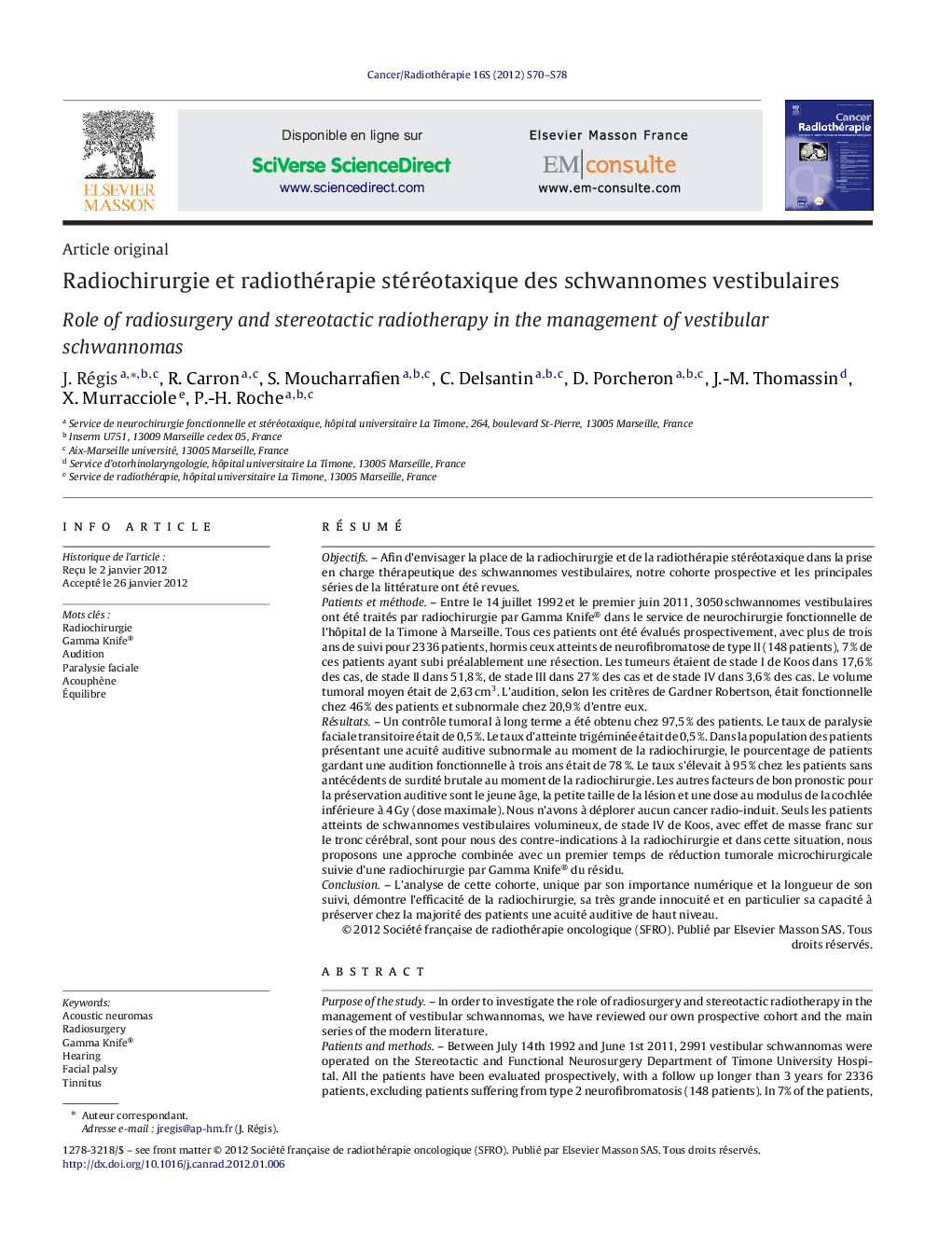| Article ID | Journal | Published Year | Pages | File Type |
|---|---|---|---|---|
| 2118304 | Cancer/Radiothérapie | 2012 | 9 Pages |
RésuméObjectifsAfin d’envisager la place de la radiochirurgie et de la radiothérapie stéréotaxique dans la prise en charge thérapeutique des schwannomes vestibulaires, notre cohorte prospective et les principales séries de la littérature ont été revues.Patients et méthodeEntre le 14 juillet 1992 et le premier juin 2011, 3050 schwannomes vestibulaires ont été traités par radiochirurgie par Gamma Knife® dans le service de neurochirurgie fonctionnelle de l’hôpital de la Timone à Marseille. Tous ces patients ont été évalués prospectivement, avec plus de trois ans de suivi pour 2336 patients, hormis ceux atteints de neurofibromatose de type II (148 patients), 7 % de ces patients ayant subi préalablement une résection. Les tumeurs étaient de stade I de Koos dans 17,6 % des cas, de stade II dans 51,8 %, de stade III dans 27 % des cas et de stade IV dans 3,6 % des cas. Le volume tumoral moyen était de 2,63 cm3. L’audition, selon les critères de Gardner Robertson, était fonctionnelle chez 46 % des patients et subnormale chez 20,9 % d’entre eux.RésultatsUn contrôle tumoral à long terme a été obtenu chez 97,5 % des patients. Le taux de paralysie faciale transitoire était de 0,5 %. Le taux d’atteinte trigéminée était de 0,5 %. Dans la population des patients présentant une acuité auditive subnormale au moment de la radiochirurgie, le pourcentage de patients gardant une audition fonctionnelle à trois ans était de 78 %. Le taux s’élevait à 95 % chez les patients sans antécédents de surdité brutale au moment de la radiochirurgie. Les autres facteurs de bon pronostic pour la préservation auditive sont le jeune âge, la petite taille de la lésion et une dose au modulus de la cochlée inférieure à 4 Gy (dose maximale). Nous n’avons à déplorer aucun cancer radio-induit. Seuls les patients atteints de schwannomes vestibulaires volumineux, de stade IV de Koos, avec effet de masse franc sur le tronc cérébral, sont pour nous des contre-indications à la radiochirurgie et dans cette situation, nous proposons une approche combinée avec un premier temps de réduction tumorale microchirurgicale suivie d’une radiochirurgie par Gamma Knife® du résidu.ConclusionL’analyse de cette cohorte, unique par son importance numérique et la longueur de son suivi, démontre l’efficacité de la radiochirurgie, sa très grande innocuité et en particulier sa capacité à préserver chez la majorité des patients une acuité auditive de haut niveau.
Purpose of the studyIn order to investigate the role of radiosurgery and stereotactic radiotherapy in the management of vestibular schwannomas, we have reviewed our own prospective cohort and the main series of the modern literature.Patients and methodsBetween July 14th 1992 and June 1st 2011, 2991 vestibular schwannomas were operated on the Stereotactic and Functional Neurosurgery Department of Timone University Hospital. All the patients have been evaluated prospectively, with a follow up longer than 3 years for 2336 patients, excluding patients suffering from type 2 neurofibromatosis (148 patients). In 7% of the patients, the vestibular schwannoma had previously been resected. According to Koos classification, in 17.6% of the patients, vestibular schwannomas were stage I, 51.8% stage II, 27% stage III and 3.6% stage IV. The mean tumour volume was 2.63 cm3. According to Garner Robertson classification, the hearing was still functional at the time of radiosurgery in 46% and subnormal in 20.9% of the patients.ResultsLong term tumour control was achieved in 97.5% of the patients. A transient facial palsy was observed in 0.5% of the cases. The rate of trigeminal injury was 0.5%. Useful hearing was preserved at 3 years in 78%. This rate reached 95% in patients with no past history of sudden hearing loss. Other predictors of functional hearing preservation are the young age, the small size of the lesion and a dose to the modiulus of the cochlea lower than 4 Gy. We observed no radio-induced tumour. Only large, Koos IV vestibular schwannomas are contraindicated for upfront radiosurgery. In these patients, we propose a combined approach with a deliberately partial microsurgical removal, followed by a radiosurgery of the residue.ConclusionThis cohort is unique by the size of the population and the length of the follow up and results demonstrate the efficacy of radiosurgery and its safety, especially its high rate of hearing preservation.
